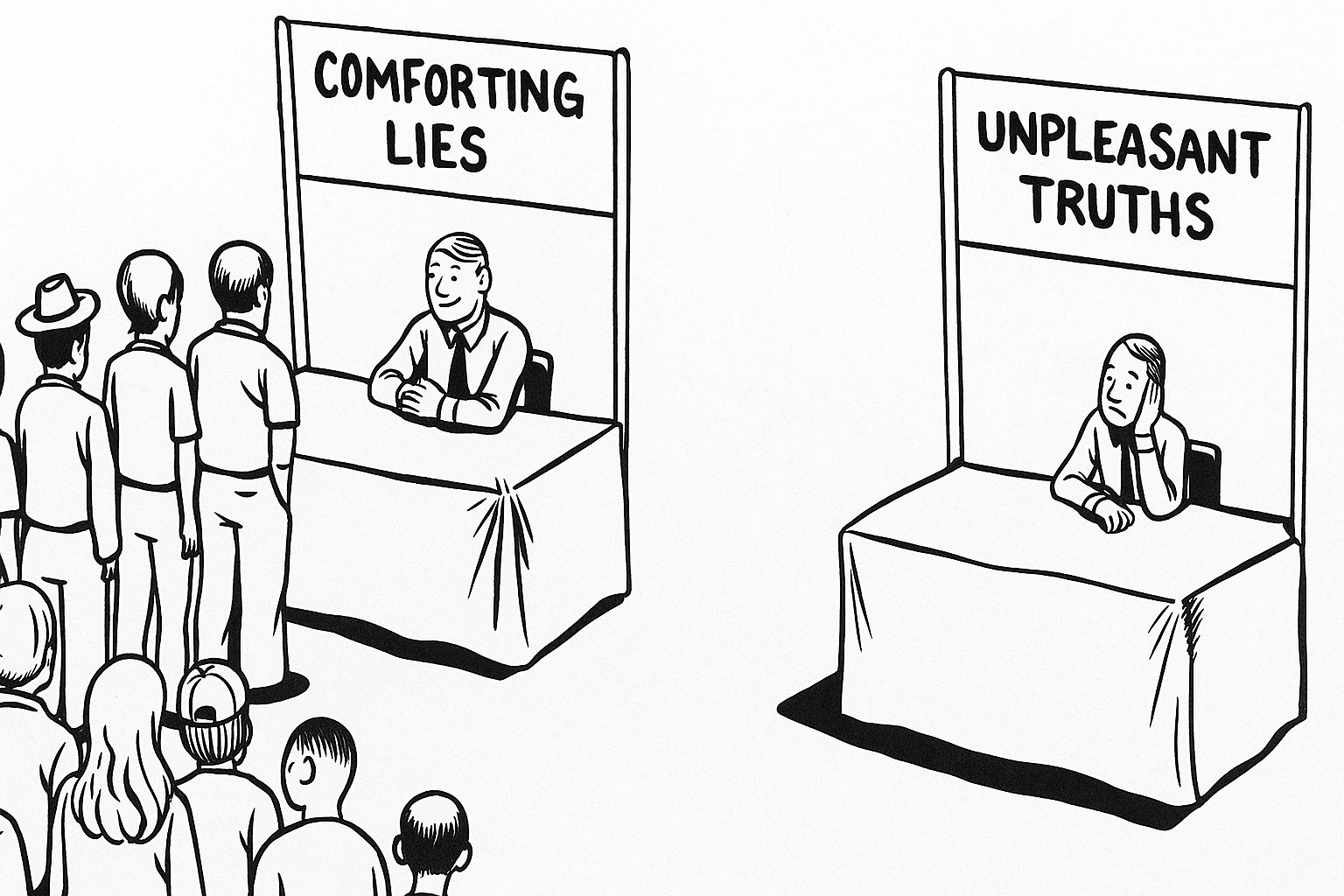(Note: This is from the Digest newsletter I send out every Tuesday. Sign up below.)
Stop Building Websites. Start Building Relationship Capital.
Relationship Capital is the only growth system that matters in service-based businesses (consulting/advisory). Not leads. Not traffic. Not brand awareness. Relationship Capital is the compound value of trust, proof, and access you’ve built over the years. Here’s how to engineer it into revenue.
Twenty years in advisory and consulting. Not one client hired me because of a homepage. For half that time, I didn’t even have one. Work came from repeat clients, introductions, and relationships I maintained with intent.
This isn’t just my experience. It’s how buying actually works in professional services.
Why Your Website Doesn’t Matter (The $2M Lie)
Your website influences 2.35% of your TAM. You just spent $2M optimizing for it. Take your CMO’s Q4 marketing budget. Add up everything they call “digital excellence” — website redesign, conversion optimization, content strategy, SEO, marketing automation, lead nurture campaigns, that new chatbot.
$2 million. Maybe more at your company. Now for the math that makes grown executives cry:
The 2.35% Ceiling
Even if we count EVERYTHING on your website as “influential” (every blog post nobody reads, every case study, every webinar recording, every testimonial), you’re reaching exactly 2.35% of your total addressable market.
Here’s the breakdown:
- 95% of your market isn’t buying right now (Ehrenberg-Bass/LinkedIn B2B Institute)
- 5% are actively buying
- 47% of those buyers consider vendor websites a “top resource” (TrustRadius 2023)
- 47% of 5% = 2.35% (That’s your ceiling). Your absolute best-case scenario. And it assumes every visitor is influenced, which we know is a fantasy.
The Real Number Is Worse
When we apply actual engagement rates:
- Only 15% meaningfully engage with marketing materials (Gartner)
- 5% read your thought leadership (Content Marketing Institute)
- 2% watch past the first 30 seconds of video (Wistia)
- 0.5% download your whitepapers (HubSpot)
Your real influence? Closer to 0.35% of your TAM.
Meanwhile, In Reality
84% of B2B sales start with a referral (Harvard Business Review). A text. A Slack DM. A dinner conversation. A former client saying, “You should talk to…”
65% of companies report referrals as their highest quality lead source (Influitive). Not the highest volume. Highest quality. The deals that close faster, buy more, and stay longer.
Referred customers have a 37% higher retention rate (Deloitte). They convert at 70% vs. 20% for web leads (Heinz Marketing).
You’re spending millions to optimize for 2.35% while starving the channel that drives 84%.
The Attribution Lie
Here’s the beautiful deception: Your buyer made their decision in a WhatsApp group at 11pm, based on their peer’s experience. They visited your website at 9am to find the contact form. Your attribution model gave the website credit.
87% of B2B buyers say peer recommendations are their most trusted source (ITSMA), but your dashboard shows “Direct Traffic – Homepage – Contact Form” as the conversion path.
The lie is beautiful. The math is not.
Where Buyers Actually Build Conviction
Buyers form opinions in places you can’t track:
- Private Slack communities where your name either comes up or doesn’t
- Text threads with former colleagues who’ve solved this problem
- Advisory boards where someone says “We used them, here’s what happened”
- Investor WhatsApp groups sharing vendor scorecards
- Industry dinners where war stories get told
When they finally hit your website, they’re confirming you exist. They check three things:
- Are you still in business?
- Do you work with companies like mine?
- How do I contact you?
The other 47 pages? Digital decoration.
The Opportunity Cost Crime
That $2M could have:
- Funded 20 Challenge Labs with key clients and prospects
- Created 10 executive roundtables in your core markets
- Produced 50 customized business cases for dream clients
- Enabled 200 strategic relationship touches
- Built a systematic referral engine generating 8-10 qualified meetings monthly
Instead, you got a homepage that converts at 0.02% and a blog nobody reads.
The Anti-Pattern Commitment
This is why I make a different choice. I turn down 3-5 opportunities monthly that would dilute my focus. A CMO needs performance marketing? Not my work. A startup wants growth hacking? I know someone better.
This selectivity makes every referral more valuable for the introducer, the prospect, and me. Specificity creates trust. Trust creates gravity. Gravity beats traffic every time.
The math is simple: Stop setting money on fire, optimizing for 2.35% of your TAM. Start building the relationship capital that drives 84% of actual sales. Your CFO will thank you. Your pipeline will prove it.
The Relationship Capital System
Goal: Six to ten qualified first meetings per month from relationships you already have
Time: 90 minutes per week
Outcome: A predictable pipeline built on trust, not tactics
Step 0: Define Your Gravitational Center
Write your ICP in one sentence. Example: North American B2B SaaS companies, 50-500 employees, working directly with the CFO or Head of Revenue Operations who needs to fix their commercial model, not their marketing.
If you can’t say no to something, you can’t own anything.
Step 1: Map Your Relationship Capital
List 25 names across three buckets:
A. Champions: Clients who’ve seen you deliver results
B. Alumni: Past buyers and power users now at new companies
C. Connectors: People with credibility in your market who understand your value
For each name, note:
- Their current priority/challenge
- Their definition of success this quarter
- Value you can provide to their priority (not selling your service)
- Three peers who they trust facing similar challenges
Step 2: Build Proof for Three Audiences
Your buyers aren’t one person. They’re a committee. Build assets for each:
Economic Buyer (CFO/Owner):
- ROI model in their language
- Payback period with sensitivity analysis
- Risk mitigation approach
Technical Evaluator (Head of Ops/IT):
- Implementation path with milestones
- Integration requirements
- Resource commitment needed
End User Champion (Team Lead):
- Day-in-the-life improvements
- Adoption path
- Tools to sell internally
One page each. No decks. These travel inside email and Slack.
Step 3: The Weekly 3-3-3 Engine
Three exploration touches: Don’t send content. Start conversations.
“I’m researching how CFOs handle [specific challenge] post-Series B. You mentioned struggling with this — what worked/didn’t work? No agenda, just mapping the landscape.”
Three strategic asks: Frame as research, not solicitation.
“I’m documenting how finance leaders navigate the 50-to-150 employee transition. You’ve done this well — who else in your circle would have an interesting perspective? Happy to share what I learn.”
Three relationship investments: Add future allies, but differently.
- Comment on their actual work, not their thought leadership
- Share their customer wins, not their content
- Introduce them to each other, not to prospects
Step 3.5: The Challenge Lab
Monthly, invite three clients to solve one specific problem together. 45 minutes. No pitch. Pure problem-solving.
Example: “Revenue Architecture Lab—Three CFOs Solving the Conversion Rate Paradox”
Participants experience your thinking, not your marketing. They meet peers. You become the curator of their peer group. Referrals happen organically.
Step 4: Make the Ask Exploration, Not Extraction
Never ask “Who should I meet?” Instead:
“I’m working with three CFOs on simplifying their revenue architecture. The pattern I’m seeing is [specific insight]. In your experience, who thinks differently about this? I’d love to pressure-test my hypothesis.”
Provide this forwardable snippet:
“Sarah is researching how B2B SaaS companies above $10M ARR are simplifying their commercial model. She’s found that companies reducing from 5 pricing tiers to 2 see 30% faster sales cycles. Thought you’d find her research interesting given your recent restructure.”
Always close the loop with insights, not outcomes.
Step 5: Track Like You Mean It
Columns that matter:
- Relationship depth (1-10)
- Their current business priority
- Last value provided (to them, not from them)
- Exploration topic discussed
- Introduction received
- Their introduction converted to meeting
- Referral velocity (time from touch to introduction)
Metrics that predict revenue:
- Referral source concentration (deals from top 5 sources)
- Unsolicited second-degree inbound (network effects)
- Time from introduction to trusted advisor status
- Percentage of clients who become active referrers
- Exploration-to-opportunity ratio (not pitch-to-close)
Step 6: The Interior Pages That Actually Matter
Keep a minimal homepage. Four lines:
- Who you help (specific)
- What outcome you deliver (measurable)
- How it works (three steps max)
- One click to “Start Here”
Invest in the pages committees actually use:
- Trust Center: Past client outcomes with numbers, industries served, typical engagement structure
- Commercial Clarity: Engagement models, typical investment ranges, procurement steps, and ROI framework
- Evidence Library by Problem: Organized by the challenge, not your solution
- Diagnostic Tool: Free, valuable, leads to conversation, not a sales pitch
The Nuclear Option Test (30 Days to Prove This)
Week 1: Password-protect your entire website
Week 2-4: Run only the 3-3-3 engine, Challenge Labs, and track every touchpoint
Week 4: Measure pipeline created vs. same period last year
This proves where growth actually originates. Most firms won’t do this. They’re addicted to the illusion of marketing. You’ll have evidence.
The Identity Test
This system works if you believe:
- Deep expertise beats broad reach
- Trust compounds; tactics depreciate
- One great referral beats 100 cold leads
- Your best next client already knows someone you’ve helped
Exploration beats exploitation
If you believe the opposite, optimize your homepage. Hire an SEO agency. Build a funnel. You’ll be competing on noise, not signal.
Your Operating Rhythm
Monday (30 min): Map this week’s 3-3-3. Review relationship priorities.
Wednesday (30 min): Send exploration touches. Prepare strategic asks.
Friday (30 min): Send asks. Log insights. Share value with referrers.
Monthly (2 hours): Host Challenge Lab. Update relationship capital map.
The Strategic Truth
Companies hire advisors through relationships. Everything else is decoration. Stop building websites. Start building the machine that compounds trust into revenue. The buyers you want are not searching. They’re asking people they trust. Be the answer in those rooms.



Leave a Reply
You must be logged in to post a comment.